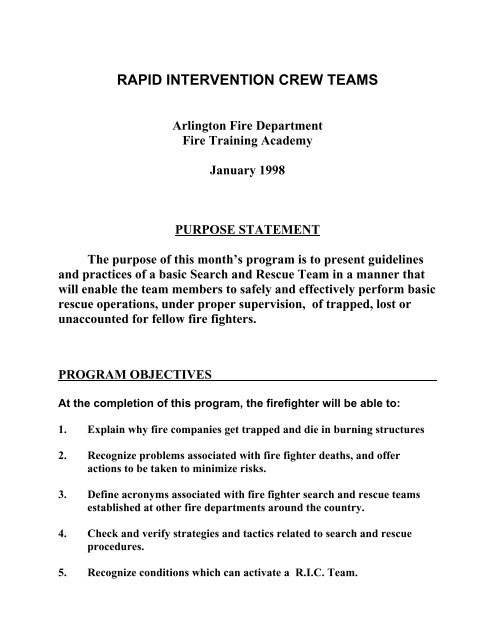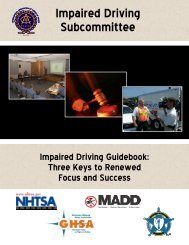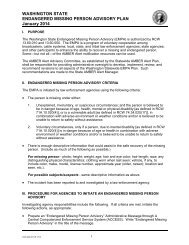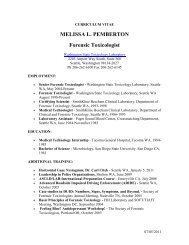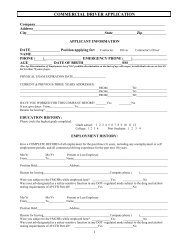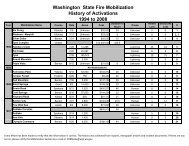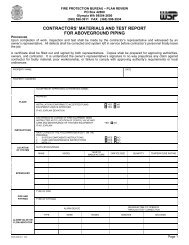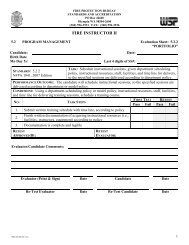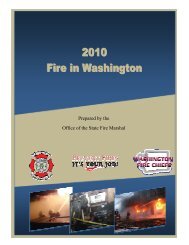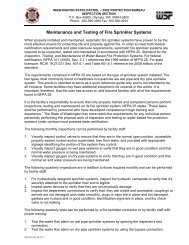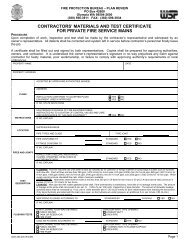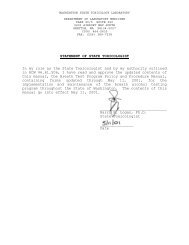Rapid Intervention Crew Teams - Lesson Plan
Rapid Intervention Crew Teams - Lesson Plan
Rapid Intervention Crew Teams - Lesson Plan
You also want an ePaper? Increase the reach of your titles
YUMPU automatically turns print PDFs into web optimized ePapers that Google loves.
RAPID INTERVENTION CREW TEAMS<br />
Arlington Fire Department<br />
Fire Training Academy<br />
January 1998<br />
PURPOSE STATEMENT<br />
The purpose of this month’s program is to present guidelines<br />
and practices of a basic Search and Rescue Team in a manner that<br />
will enable the team members to safely and effectively perform basic<br />
rescue operations, under proper supervision, of trapped, lost or<br />
unaccounted for fellow fire fighters.<br />
PROGRAM OBJECTIVES<br />
At the completion of this program, the firefighter will be able to:<br />
1. Explain why fire companies get trapped and die in burning structures<br />
2. Recognize problems associated with fire fighter deaths, and offer<br />
actions to be taken to minimize risks.<br />
3. Define acronyms associated with fire fighter search and rescue teams<br />
established at other fire departments around the country.<br />
4. Check and verify strategies and tactics related to search and rescue<br />
procedures.<br />
5. Recognize conditions which can activate a R.I.C. Team.
6. Recall when and where to establish a R.I.C. team.<br />
INTRODUCTION:<br />
One of the most common situations in which a rescue unit is needed is for rescue<br />
operations on the fireground. The primary reason for having a rescue unit at a<br />
working fire is to rescue trapped or overcome firefighters. When firefighters are in<br />
trouble, it is often the specialized training and equipment that the rescue unit has<br />
that are needed to save them. A well-trained and well-equipped rescue unit can be<br />
an extremely valuable resource on the fireground.<br />
This month’s program will address this very important issue of search and rescue<br />
units on the fireground. More specifically called <strong>Rapid</strong> <strong>Intervention</strong> <strong>Crew</strong>s.<br />
While searching a fire building for civilian occupants is the task most frequently<br />
assigned to a rescue company, the primary reason for having a rescue unit at a<br />
working fire is to rescue trapped or overcome firefighters. When firefighters are in<br />
trouble, it is often the specialized training and equipment that the rescue unit has<br />
that are needed to save them.<br />
LESSON TITLE:<br />
<strong>Rapid</strong> <strong>Intervention</strong> <strong>Crew</strong> <strong>Teams</strong><br />
Classroom Hours -1.0<br />
PERFORMANCE OBJECTIVE (S):<br />
At the completion of this program, the fire fighter will be able to:<br />
1. Explain why fire companies get trapped and die in burning structures<br />
2. Recognize problems associated with fire fighter deaths, and offer<br />
actions<br />
to be taken to minimize risks<br />
3. Define acronyms associated with fire fighter search and rescue teams
established at other fire departments around the country<br />
4. Check and verify strategies and tactics related to search and rescue<br />
procedures<br />
5. Recognize conditions which can activate a R.I.C. Team<br />
6. Recall when and where to establish a R.I.C. Team<br />
MATERIALS AND SUPPLIES:<br />
Television Monitor<br />
Video Cassette Recorder<br />
INSTRUCTIONAL AIDS:<br />
Handouts – 3<br />
Exercises – 1<br />
Videotape - 1<br />
REFERENCES:<br />
INTRODUCTION:<br />
One of the most common situations in which a rescue unit is needed is for<br />
rescue operations on the fireground. The primary reason for having a rescue<br />
unit at a working fire is to rescue trapped or overcome firefighters. When<br />
firefighters are in trouble, it is often the specialized training and equipment<br />
that the rescue unit has that are needed to save them. A well-trained and<br />
well-equipped rescue unit can be an extremely valuable resource on the<br />
fireground. This month’s program will address this very important issue of<br />
search and rescue units on the fireground. More specifically called in the<br />
Arlington Fire Department, <strong>Rapid</strong> <strong>Intervention</strong> <strong>Crew</strong>s.
PRESENTATION:<br />
INSTRUCTIONAL TOPICS<br />
THINGS TO DO OR SAY<br />
INTRODUCTION<br />
( 2 minutes)<br />
Objectives 1,2,3, 4, 5, 6<br />
A. State the purpose of this month’s program to participants<br />
B. Introduce this month’s program to participants<br />
PROGRAM OBJECTIVES<br />
( 4 minutes)<br />
Objectives 1, 2, 3, 4, 5, 6<br />
A. Distribute Handout # 1 to participants<br />
B. Review Program Objectives with participants<br />
C. Explain this month’s program offers guidelines to be<br />
considered for establishing a R.I.C Team in the<br />
Arlington Fire Department.<br />
REASONS COMPANIES A. Distribute Handout # 2 to participants<br />
GET TRAPPED AND DIE<br />
( 15 minutes) B. Review Handout # 2 with participants<br />
Objectives 1<br />
C. Discuss each of the items separately with the participants<br />
Allow participants to offer solutions for each<br />
reason listed on Handout # 2<br />
VIDEOTAPE PROGRAM<br />
( 19 minutes)<br />
Objectives 1,2,3,4,5,6<br />
A. Introduce videotape program to participants<br />
B. Show videotape program to participants<br />
DISCUSSION QUESTIONS<br />
( 10 minutes)<br />
A. Distribute Handout # 3 to participants
Objectives 2 B. Open a discussion with participants on “Actions to<br />
Be Taken” by Lost/Trapped Firefighters<br />
C. Review Handout # 3, and ensure that each participant<br />
recognizes the proper sequence of actions to be taken if<br />
lost, trapped or unaccounted for during an incident<br />
GO TO SUMMARY SECTION ( Last Page)<br />
SUMMARY<br />
This month’s program introduced the concept of <strong>Rapid</strong> <strong>Intervention</strong> <strong>Crew</strong>s<br />
and guidelines to be followed to minimize the lost of life and prevention of<br />
injuries due to firefighters being trapped in burning structures. The National<br />
Fire Protection Association and the Occupational Safety and Health<br />
Administration suggests that all fire departments would benefit from having<br />
skilled personnel trained to respond to emergencies involving fellow<br />
firefighters who get trapped or lost.<br />
This program has explained why companies get trapped. How to recognize<br />
problems associated with fire fighter deaths. How to recognize conditions<br />
which can activate a <strong>Rapid</strong> <strong>Intervention</strong> <strong>Crew</strong>, and actions to be taken if lost<br />
or trapped. And where to establish a <strong>Rapid</strong> <strong>Intervention</strong> <strong>Crew</strong> on the fire<br />
ground.<br />
APPLICATION<br />
Involvement by all participants in the practice phase of this program will<br />
ensure that proper actions will be taken to minimize the exposure of rescue<br />
personnel to serious injuries in the performance of their duties.<br />
Train on Buddy Breathing and changing out depleted air bottles of a trapped<br />
firefighter. Train in using tools in darkened confined areas. Search and Find.<br />
Take training seriously.<br />
EVALUATION
KNOWLEDGE DEMONSTRATION EXERCISE<br />
APPROXIMATE TIME FOR COMPLETION OF THE KDE: 15 minutes<br />
1. Distribute blank KDEs to each firefighter.<br />
2. Have each firefighter complete the exercise and return for evaluation.<br />
3. Complete Monthly Training Record for each member.<br />
REASONS COMPANIES GET TRAPPED AND DIE<br />
◙<br />
◙<br />
◙<br />
◙<br />
◙<br />
◙<br />
◙<br />
◙<br />
◙<br />
Conditions deteriorate rapidly<br />
Inexperienced Officers<br />
Water Loss<br />
Improper Size-up<br />
Failure to Follow Basic Safe Fire Principles<br />
Failure to Identify Possible Problems during Pre-planning<br />
Energy-efficient Windows<br />
Failure to Detect Secondary Fires<br />
Fire fighter getting above fire without knowing it
INTRODUCTION<br />
ACTIONS TAKEN BY LOST/TRAPPED<br />
FIREFIGHTERS<br />
aCall for Help “ May Day”<br />
aActivate P.A.S.S.<br />
aStay Together ( if possible)<br />
aFollow Hose Line or Life Line<br />
aConserve Air Supply<br />
aUse Light, Radio ( if working)<br />
aDescribe Surroundings<br />
RIC TEAM SCRIPT<br />
We know that the NFPA and OSHA require a minimum of two firefighters outside<br />
the hazard zone, whenever a hazard zone is established. But what we need to<br />
understand is why we should form a RIC (<strong>Rapid</strong> <strong>Intervention</strong> <strong>Crew</strong>) team instead<br />
of depending on the old standard of personnel and equipment already on the scene.<br />
A RIC team is immediately available to be placed into action. It provides us with a<br />
fresh team of skilled personnel. It provides us with a team that has already gathered<br />
vital information for ascertaining rescues. It provides us with a team that already<br />
has the rescue tools needed for most rescue scenarios. And this team is readily<br />
identifiable by the RIC team tags that are applied to their helmets.<br />
REASONS COMPANIES GET LOST/TRAPPED/DIE<br />
Conditions deteriorate rapidly. Obvious reasons might be due to inexperienced<br />
officers sometimes having tunnel vision, or they react too quickly. Conditions<br />
dictate they should have gone into a defensive mode, water loss, error by the AO,
usted lines, improper size-up, back draft, heavy fire in rear, failure to follow basic<br />
safe fire principles, not wearing helmets, not using SCBAs, failure to identify<br />
possible problems during pre-fire planning, basement areas, no fire walls, gang -<br />
plate construction, energy efficient windows that hold heat inside the structure and<br />
decrease your ability of escape quickly. Failure to detect secondary fires up above<br />
leading to a collapse. Firefighter unknowingly gets above the fire. Or being<br />
unaware of a basement below.<br />
REPORTING TO INCIDENT COMMANDER:<br />
RIC teams report directly to the IC. IC briefs the RIC team members. This would<br />
be the time the IC would give the RIC team members an overview of what is going<br />
on, and what could possibly go wrong. At this time he/she might go ahead and<br />
inform the RIC Team members why the RIC team is being formed, what his/her<br />
expectations are, and a little bit of information regarding his/her strategy and<br />
tactics.<br />
WHERE TO ESTABLISH A RIC TEAM:<br />
RIC teams need to be near the Command Post. They need to be visible to<br />
command so he/she can call them into service at a moments notice. They should be<br />
within verbal contact of the Incident Commander. Remaining out of the way, but<br />
being alert to emergencies and conditions around them, and any changes that could<br />
be taking place in the hazardous zone. The team should be monitoring radio<br />
communications so if needed, they will have a better understanding of what is<br />
going on and what will probably be necessary.<br />
ACTIONS NEEDED:<br />
These are the actions that need to be considered by the IC once the decision is<br />
made to activate the RIC team:<br />
The Victim- Call for help, “May Day”, Activate PASS, stay together, if possible,<br />
follow hose or life line, conserve air supply. One suggestion here if you do run out<br />
of air, be aware that if you do breach the pipes in the wall there is air in those areas<br />
that might be able to help you survive until help arrives.
PRACTICE AND TRAIN SAFETY:<br />
Train on Buddy Breathing and changing out depleted air bottles of a trapped<br />
firefighter. Train in using tools in darkened confined areas. Search and Find. Take<br />
training seriously.<br />
RIC TEAM BAGS:<br />
The RIC Team Bag is a proposed bag that we are trying to implement to placed in<br />
each Battalion Chief’s van. This would allow any company that is available at the<br />
scene of an incident to become a RIC Team rather than just having Truck<br />
companies as RIC <strong>Teams</strong>. The proposed contents of the bag would be as follows:<br />
Rescue Rope with knots every 10 feet.<br />
Spare radios so each RIC Team member would have his or her own radio<br />
Heavy duty lights,<br />
Extra Air Bottles,<br />
RIC decals for the helmets so each member would be readily identifiable<br />
We are attempting to get infrared scopes to increase visibility in the dark thus<br />
making rescue efforts a lot quicker.<br />
SUMMARY:<br />
Remember a RIC Team’s primary responsibility is to locate the victims and rescue<br />
them, if possible. Time is of the essence. RIC <strong>Teams</strong> cannot possibly carry all the<br />
tools that they will need for rescue. Don’t forget, if the situation calls for<br />
assistance, then call them! You have manpower and equipment standing by<br />
outside, and a city full of resources. Remember to try and keep a RIC Team in<br />
place, but if the crew is needed by IC, it will be necessary to replace them. As long<br />
as the emergency is ongoing and crews are in the hazard zone a RIC team has to be<br />
in position. The RIC Team is a new concept for fire departments nationwide. But<br />
remember, the team itself is only as good as the department that trains and supports<br />
this tactic, along with the crews that dedicate themselves to it.


